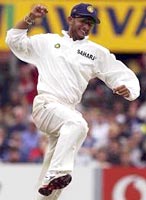A note of caution
Daniel Laidlaw
There's that ominously deceptive tag rearing its head again in optimistic reports on India's series prospects: favourites. Deceptive, at least, insofar as anyone pays attention to it. For we should not overlook the reasons why India won the third Test to draw level at 1-1, and how those reasons all too tenuously serve as guarantees of success in the decisive fourth.
In attributing India’s third Test victory to team effort, Sourav Ganguly summarised it perfectly. The outstanding feature of the determined and ultimately re-invigorated win was the number of contributors to the outcome. No player could be said to have solely swayed the result.
 To briefly review, Bangar, Dravid, Tendulkar and Ganguly all played greater or lesser roles in establishing the strongest possible base from which the bowlers could build pressure on England's batsmen. Then Kumble, Harbhajan, Bangar, Zaheer and Agarkar each played a part in procuring the 20 wickets India had to have after managing only 16 at Lord's and 10 at Trent Bridge.
To briefly review, Bangar, Dravid, Tendulkar and Ganguly all played greater or lesser roles in establishing the strongest possible base from which the bowlers could build pressure on England's batsmen. Then Kumble, Harbhajan, Bangar, Zaheer and Agarkar each played a part in procuring the 20 wickets India had to have after managing only 16 at Lord's and 10 at Trent Bridge.
It was the way, really, it had to be. After the wayward displays in the first two Tests, the now spin-based attack relied heavily on the position so superbly afforded them by the batsmen. While it's been argued here that bowlers are always the real match-winners, an unassailable total was in this case a necessity in order for Kumble and co. to fully regain their self-belief as wicket-takers rather than touring hopefuls.
What now needs to be taken into account is that starting positions of such dominance are rare. 600 totals cannot, will not, be produced on a regular basis to win Tests. Therefore, there must still be some concern that India may be somewhat unbalanced in batting-to-bowling strength, because a total even of 450 may not be sufficient for anything more than a draw. We shall see. At least, though, India appears to have found its formula. Gone is the impression of diffidence and confusion. Judging from Sourav Ganguly’s comments, he has confidence India knows what it's doing, and that has shown through.
Still, as much as it is easy to assent that yes, India is now on track, and because of the change witnessed should win the last Test, a note of caution must still be sounded. England will not remain the same side ready to be beaten, any more than it can be presumed India will be the same one poised to deliver the knockout blow. As India have ever so gradually progressed as an away team, Nasser Hussain and England have appeared keen to embrace the bigger picture, and have clearly sought to be known for their fighting spirit, not derailed by poor days or matches. Come to think of it, Hussain and Ganguly may have more in common as captains than people think. Whatever, England have made changes with Trescothick and Harmison returning, and expectations should not be inflated as they possibly were following the NatWest series success.
As the differences between one-day and Test cricket should be clearly delineated so, perhaps, should the momentum of individual matches in a series. Winning momentum is of course tremendously important, but only as long as the effort that created it is sustained and not assumed to be concomitant once forged, which one suspects has been a danger with India.
 Satisfaction is justified in savouring an unexpected victory, but the crucial end of a series when the ultimate result remains at stake is perhaps not the most appropriate time for a captain to fire back at critics and point to records, as Ganguly must have come close to doing in his comments reported on rediff recently. That can be done after the series, whether in victory or defeat. By doing it before, after one resounding but incomplete step, Ganguly only runs the risk of supplying more ammunition for critics who would use it against him when India next stumble.
Satisfaction is justified in savouring an unexpected victory, but the crucial end of a series when the ultimate result remains at stake is perhaps not the most appropriate time for a captain to fire back at critics and point to records, as Ganguly must have come close to doing in his comments reported on rediff recently. That can be done after the series, whether in victory or defeat. By doing it before, after one resounding but incomplete step, Ganguly only runs the risk of supplying more ammunition for critics who would use it against him when India next stumble.
Besides, what really should be taken from the third Test and into the last is not the perception that "see, we've been playing like a top side all along, it's just that no-one noticed it before" (which is the impression given, wrongly or not, by Ganguly's remarks) but rather "this is what we should have been doing throughout". Whatever particular attitude, motivation or preparation the Indians used in the third Test, whether it was out of the ordinary or just a happy coalescence of minor factors, should be summoned again. Scores can be settled and points made afterwards.
Without knowing the conditions expected at The Oval, it will be fascinating should England bat first. Then, it would likely become incumbent upon Zaheer and Agarkar to establish the trend of the match, and having the seam bowlers responsible for that proved disastrous in Tests one and two. In the event of bowling first, one imagines there might be thoughts not only of winning, as in the third Test, but crucially not losing as well, to which the bowlers reacted poorly in the first half of the series. The importance of ignoring what cannot be controlled need not be detailed again; ideally for India, it does not come to that.
But even with an invulnerable first innings score behind them, the Indians at times appeared unsure of themselves. The anxiety when Hussain and Stewart offered some resistance on day four at Headingley -- and the exultant celebrations at the fall of each wicket -- suggested an unfamiliarity with dominating from start to finish and knowledge of how to finish a crippled opponent off. Really, that was not so surprising: India had, after all, never before dominated to such an extent in an away match. Instinct and team effort paved the way, to a result built on India playing to its strengths. They should cling ferociously to them again.
More Columns
Mail Daniel Laidlaw